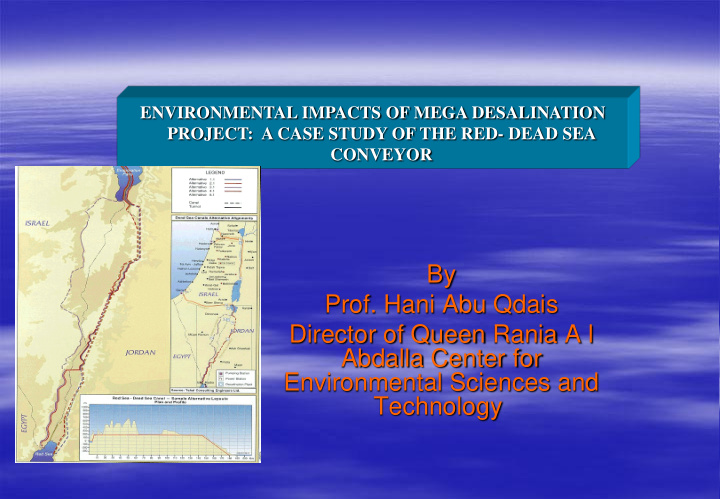



ENVIRONMENTAL IMPACTS OF MEGA DESALINATION PROJECT: A CASE STUDY OF THE RED- DEAD SEA CONVEYOR By Prof. Hani Abu Qdais Director of Queen Rania A l Abdalla Center for Environmental Sciences and Technology
Water Availability Most Middle Eastern countries are facing a chronic water shortage Some of the countries are considered among the water poorest countries worldwide Need for reliable water resources 2
RED DEA CONVEYOR Euphrates River Lebanon Syria Lake Tiberius Iraq Israel West Bank Mediterranean Sea Dead Sea Jordan River Nile Eilat/ Aqaba Egypt Saudi Arabia 3 Red Sea
PROJECT DETAILS Phase 1: Water transfer from Red Sea to Dead Sea At a cost of US$1 billion Distance : 180 km Annual water transfer: 1,900 mcm/yr Alignment – Wadi Araba Phase 2: Hydropower and freshwater production At a cost of US$1-1.5 billion Hydroelectric power generation Reverse osmosis desalination facility Freshwater production Phase 3: Freshwater and excess electricity capacity – 850 mcm/yr distribution Freshwater Transmission and distribution system to demand centers Transmission system for of electricity 4
Why The Red-Dead Project? Meeting the ever increasing water demand (850 MCM of Fresh water) Generating Power Preserving the DEAD SEA from vanishing
Why The Red-Dead Project? Importance of The Dead Sea The uniqueness comes from: 1- Location, Climate and Properties 2- Cultural and religious treasure 3- Unique environment 4- Economic attraction
Location, Climate, Properties The Dead Sea is the lowest spot on earth (417 meters below sea level) Dead Sea water contains more than 30% mineral rich salts. Salinity is 10 times higher than sea water. It has a unique mud that is rich in minerals,
A Cultural and Religious Treasure Origin and/or center of religions and cultures Biblical history Dome of the Holly Rock and places of pilgrimage Pop John Paul II visit to Baptism site
Unique Environment A unique eco-system housing rare wildlife and endangered species Sandstone Formations Spectacular landscape with rare attributes Multiple Natural Reserve
Economic Attraction Huge tourism potential Unique medical and health resources Mineral Dead Sea products Potash Industry
What is the problem ?
WATER SHORTAGE High rate of population growth implies higher demand on the limited water resources.
DEAD SEA VANASHING Average annual inflow to the Dead Sea has decreased from natural 1,200 mcm/yr to about 250 mcm/yr, leading to a water level decline of about 1 m/year. This decline resulted from the vital human water requirements in this water-scare and arid region. Water level dropped by 24 meters, surface area shrank by about 33% in the last 55 years. 80% of this decline has occurred since the 1970 ’ s.
Dead Sea Water Budget Jordan River Evaporation Rainfall 1500 mm 90 mm 10% of Jordan 90% used by River flows to the agriculture and Dead Sea potable water Dead Sea Surface area Current (-417) = 637 km 2 Historical (-395) = 940 km 2
Consequences Dead Sea level has fallen from 393 to less than 417 Year Level, Area, Sq. meters below sea level in less m Km than 55 years 1950 -393 1043 1975 -397 926 More than 24 meters of sea 2000 -414 642 level fall 2005 -417 637 Current rate of decline is 2020 -427 622 approximately 1m per year 2050 -447 582
The Dead Sea . . . in time 1960 2000 2050
If no action is taken … Loss of historic Dead Sea within 50 years Loss of valuable ground water resources and formation of sink holes Ecological Imbalances: hydrologic systems, land quality, plant and wildlife habitats
ENVIRONMENTAL COST OF MEGA PROJECTS Both positive and negative impacts should be considered 18
POSITIVE IMPACTS Creating a reliable source of water on a regional scale that will relive the pressure from the already exhausted conventional water resources Positive impacts on the regional socio-economic development Restoring the Dead sea to its historical level Preventing the formation of sink holes Creating hundreds of jobs 19
ADVERSE IMPACTS There is a mutual interaction between the desalination plants and the sea environment . Feed water 20
Impacts on the Gulf of Aqaba The Gulf of Aqaba is considered as a semi enclosed water body with fragile environment. Gulf length (180 km) to the Strait of Tiran outlet width (6 km). Atypical oceanographic characteristics of this semi-enclosed portion of the Red Sea have resulted in the evolution of biological diversity that is unique to the Gulf of Aqaba (Coral reefs) Impacts during construction and operation 21
Impacts on the Gulf of Aqaba Construction phase Excavation will disturb the beach sand and produce sediments Heavy equipment that will compact the beach sand and affects the biodiversity Noise from the construction equipment Spill of chemical and machinery oil 22
Impacts on the Gulf of Aqaba Operation phase During the operation phase, intake of water directly from the sea usually results in loss of marine species as a result of impingement and entrainment Noise of the pumping equipment Spillage of oil and grease that will be used for the operation and maintenance of the pumps 23
Impacts on the Dead Sea Brine Discharge of 72,220 mg/l to a dead sea water which is a hyper saline water body (Different Densities) Chemicals will be introduced into the dead sea water Solid waste (Spent membranes) Geological and Seismological impacts 24
Conclusions & Recommendations Red-Dead project is a Mega Scale project and first of its type A well designed Environmental Impact Study should be conducted to maximize the Benefits and Eliminate and/or minimize the adverse impacts A comprehensive environmental management plan should be placed and applied during the construction of the intake structure. 25
Thank you
Recommend
More recommend